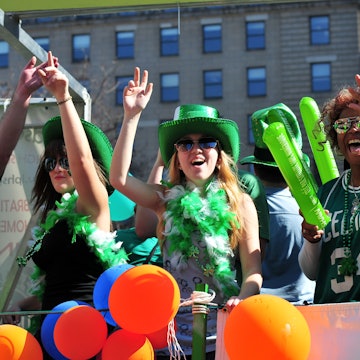
8 Christmas traditions from around the world explained

Nov 24, 2024 • 5 min read

Riga in Latvia is one of the cities that claims to have invented decorating fir trees at Christmas. Maria Vonotna/Getty Images
Ever wondered who first decided to bring trees inside to celebrate Christmas? Or where advent calendars first originated from? We’ve tracked some popular festive traditions and some lesser-known ones back to their roots.
Read on for the more on the many ways the world celebrates Christmas.

1. Hanging Advent calendars in Germany
Advent, which derives from the Latin word adventus, meaning “coming,” is the period beginning four Sundays before Christmas. In the 19th century, German Protestants counted down the days to Christmas by marking 24 chalk lines on a door and rubbing one off every day in December. Paper Advent calendars became popular in Germany in the early 20th century.
Gerhard Lang is thought to have been the first to mass-produce them, inspired by a calendar his mother had made for him as a child. He later came up with the idea for cardboard calendars with doors that could be opened. They became a commercial success, but it wasn't until the late 1950s that Advent calendars included chocolate. During today's Christmas season, you can see giant Advent calendars on building facades in many European towns and cities. Hattingen in North Rhine-Westphalia and Bernkastel-Kues in Moselle Valley, both in Germany, have some pretty examples, as does Innsbruck, Austria.

2. Decorating fir trees in Europe
Pagan Europeans would bring a fir tree into the home during the winter solstice. Tree worship was common, and they would also decorate a living tree outdoors with candles and ornaments symbolizing the sun, moon and stars on the tree of life. In Scandinavia, people decorated their homes and barns with greenery for New Year to ward off evil. Since evergreens symbolize eternal life, greenery helped Europeans visualize the spring to come.
It’s not known exactly when Christians began to use fir trees as Christmas trees, but the cities of Tallinn in Estonia and Riga in Latvia lay claim to the first documented use of a public tree at Christmas and New Year celebrations. Today, Christmas trees around the world are usually fir, spruce or pine trees.

3. Noche de las Velitas (Night of the Little Candles) in Colombia
On December 7, Colombia honors Mary, the mother of Jesus, and the Feast of the Immaculate Conception with Noche de las Velitas (Night of the Little Candles), an enchanting celebration that marks the start of the holiday season. Colombians light up their homes and streets with millions of white and colored velas (candles) in patterned paper lanterns. The Night of the Little Candles was once a small-scale, family-centric affair, but over the years the decorations have become more creative and sophisticated, and electric lights are often used. Celebrations have become increasingly public too, with music and fireworks as well as food markets.
You can see something similar in Santa Fe, New Mexico, in the beloved Christmas Eve Farolito Walk up Canyon Road. Here, the tradition calls for simple paper bags filled with a bit of sand and a tealight.

4. Celebrate Christmas on January 7 in Ethiopia
The Christmas story tells us that three wise men, also referred to as magi or kings, followed a miraculous guiding star to Bethlehem “from the East” to pay homage to the infant Jesus. It’s generally thought the magi came from Asia, Europe and Ethiopia. Many Ethiopians believe that all three wise men (some say it was 12) were Ethiopian.
Ethiopians follow the Julian calendar, which means they celebrate Christmas, known as Ganna or Genna, on January 7. People dress in white, with most wearing the traditional netela – a thin white cotton scarf with brightly colored stripes across the ends. Draped like a shawl or toga, it makes those wearing it look very kingly indeed.

5. Giving poinsettias in Mexico
Poinsettias, which bloom in winter, are indigenous to Central America, specifically to southern Mexico around Taxco del Alarcon and the state of Oaxaca. A Mexican legend tells of a girl who had nothing but a bunch of weeds to offer the baby Jesus at a Christmas Eve service. When she knelt to place the weeds by the nativity, the bouquet burst into bright red flowers. Ever since then, the flowers, whose leaves are said to be shaped like the star of Bethlehem, have been known as the Flores de Noche Buena, or Flowers of the Holy Night, and have become synonymous with Christmas.

6. La Quema del Diablo (Burning of the Devil) in Guatemala
Guatemalans practice a Christmas season ritual that’s unique in the world. At sunset on December 7, the eve of the Feast of the Immaculate Conception, people gather in towns and villages across Guatemala for La Quema del Diablo (Burning of the Devil). Since the 17th century, people here have believed that burning an effigy of the devil will cleanse their homes of the evils and misfortunes suffered in the previous year.
Today, communities gather in plazas to light bonfires and burn the devil, often a piñata, at 6pm. Vendors sell devil horns and firecrackers, and many revelers wear devil disguises. Afterward, families come together to eat buñuelos (traditional donuts) and drink warm fruit punch.

7. Midnight mass in Rome
Many theologians believe the tradition known as midnight mass originated with pilgrims to what is now Israel. In the late 4th century, a pilgrim from Rome joined a group of Christians in a vigil in Bethlehem on the night of January 5 – Christmas Eve in the Eastern tradition. The vigil was followed by a torchlight procession to Jerusalem, culminating with a dawn gathering. When the Basilica of Santa Maria Maggiore was built in the 5th century, Pope Sixtus III introduced midnight mass on Christmas Eve in the chapel, a tradition that has since spread to many Christian countries worldwide.
8. Réveillon de Noël (Christmas Eve) in Québec
In Québec, French-speaking families celebrate Christmas on the evening of December 24. It’s a late-night to early-morning event, hence the term réveillon, which comes from the French word réveil, meaning “wakening.” The tradition originated in France and is similarly celebrated in New Orleans.
Traditionally, families would attend midnight mass before returning home, where Santa Claus would magically appear to dole out gifts. Once these were opened, everyone moved to the table for a gluttonous meal of tourtière (minced meat pie), mashed potatoes, turkey with stuffing and coquilles Saint-Jacques (scallops in the shell), followed by bûche de Noël (Yule log cake) and sucre à la crème (sweet tablet, made from sugar and cream). For those still standing, the festivities might last until dawn.













